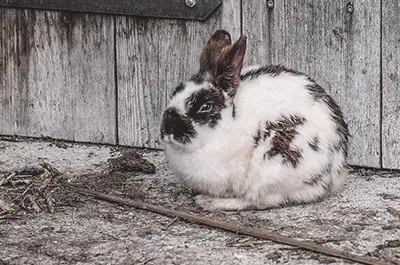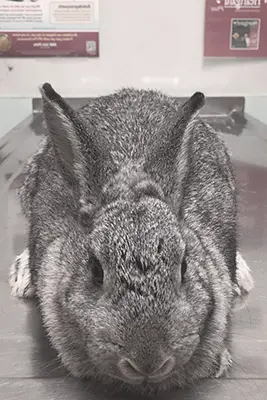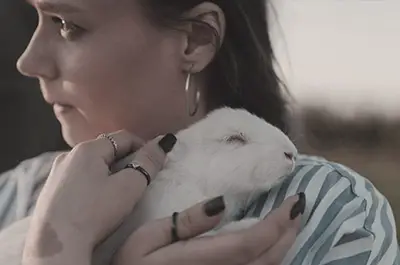Whether you just brought home your first pet rabbit or have had one for a while, it’s important to learn how to take care of him properly. Rabbits are interesting and complex animals and require specific care to live long, healthy lives. This guide will walk you through everything you need to know to make your bunny happy and healthy. From diet to housing to exercise, we’ve got you covered!
Prepare a Safe Space for Your Bunny.
Before you do anything else, make sure that your pet has a safe space prepared for him to call his own. This should be an area where he can be away from other pets or children. You should also avoid placing his cage in direct sunlight or near any other source of heat.

A good idea is to have a wire cage with a bottom and a top. This allows fresh air in while still giving your pet a sense of security. You can also line the bottom of his cage with newspapers to make for easy cleanup if he has an accident during house training.
Make sure his housing is large enough. The rule of thumb for a bunny’s cage is 10 inches (25.4 cm) of cage space for each pound your pet weighs, so make sure his living quarters are big enough for him to hop around in and stretch out.
If you use a solid floor, make sure to provide your bunny with a box filled with hay for him to snuggle in. This will give him a safe, dark space to go when he wants a little privacy.
You should also provide him with shelter outside of his cage. This can be a simple cardboard box with a blanket inside or even just a plant on its side. This will help him feel more at home in your absence and let him have a safe place to retreat when he’s feeling anxious.
Some good options include building a pen in an extra room, such as a bedroom or laundry and other animals. You may also want to keep your rabbit here for a few days after you bring him home if he needs to be isolated from your other pets for medical reasons.
Prepare Your Home for Your New Pet.
Be sure the area is bunny-proofed. Cover electrical cords, air vents, and other things that your rabbit could get into if not adequately protected. If you have any houseplants with potentially poisonous leaves, place these in an area that your rabbit can’t reach.
You’ll also need to provide your rabbit with a place to climb, play, and exercise. This can be a cat or ferret tree or even a cardboard box with a towel draped over the side. Just make sure it is large enough for your rabbit to stretch out and not feel confined.
You also may want to put down some newspapers or puppy pads in your home. These will make for easier cleanup when you’re house training your pet, and they will also keep your rabbit from eating items in your home that could make them sick.
How to Pick the Right Food for Your Pet Rabbit.
Once you’ve set up a safe space for your pet, the next step is to ensure that all of his necessities are available.
First and foremost, you’ll need to have a water source for him. If you keep his cage in an area where he’ll have access to a sink, you can leave the water there for easy access. However, if your pet is housed in a room away from other animals or people, you’ll need to provide him with water elsewhere. This can be done either with a water bowl or a water bottle, whichever you prefer.
Water should be changed daily to avoid bacteria buildup. When it comes to food, your bunny should have access to hay at all times.
Hay is an integral part of your rabbit’s diet, as it will provide them with essential nutrients they need to keep their digestive system running smoothly. Your pet will also need daily greens to supplement their diet in the form of lettuce or spinach. This should be given to them after they have eaten their hay for the day.
In addition to hay and greens, your pet will need a small number of fresh vegetables, as well as a small amount of pellet food. However, your rabbit’s diet should be mostly hay and greens, so the pellets are mostly a supplement.
Most rabbit experts recommend that you avoid feeding your pet fruits, as they are too high in sugar and can cause serious health problems.
You’ll also need to keep bunny-safe toys around for your pet.
Buy toys to keep your bunny occupied. Since bunnies are naturally prey animals, they need mental stimulation and room to exercise. If they are not given enough toys, they will get bored and depressed.
These can include cardboard boxes with treats hidden inside, balls that they can push or roll around with their noses, rings, and even wooden blocks for him to chew on, and other such items. Be aware that, while your furry friend will likely enjoy playing with toys, he may also get bored of them quickly. So be sure to rotate his toys often, so he doesn’t lose interest in them.
Ensure that these are kept in an area of your home where they can’t be easily accessed by other pets, especially cats. While rabbits can get along just fine with other animals, cats have been known to try and play rough with these smaller pets.
Choose a vet for your rabbit.

You should also make sure that he is spayed or neutered.
If you’ve adopted your pet from a shelter, the staff should have advised you on the proper schedule for this. For rabbits you’ve raised yourself, your vet can help you determine an appropriate time for getting your pet spayed or neutered.
You should also have your rabbit checked over for any signs of illness after bringing him home, so he can be treated if necessary. After this exam, make sure that you brush your rabbit to remove any loose fur or debris that might have gotten on them during the visit.
You’ll need to learn what they like and don’t like.
For instance, rabbits are prey animals, so they tend to jump around sudden sounds. They may startle easily when people walk past their cages or drop things unexpectedly. Your pet will also likely become stressed if confined to a small space for an extended period, so you must allow them to exercise. If you are not sure what your pet likes, try stroking different areas of their body to get a sense of their comfort.
It’s important to learn what your pet dislikes as well, though. For instance, rabbits tend not to like being picked up or held. If someone holds them, they will usually struggle to escape and may even begin kicking with their legs as a defense mechanism. If this happens, it’s best not to keep trying to pick up your pet. Once you know these things, it will be much easier to care for your bunny.
Keep your rabbit clean by brushing them.
Rabbits are extremely clean animals and will spend a lot of time grooming themselves. However, they still need to be brushed every now and then to remove any dirt or debris that could cause their fur to become matted. You should also brush your pet’s teeth every day, as they are very prone to tooth decay. Since rabbits eat a lot of hay, they tend to accumulate a lot of hay dust in their mouth, which can cause serious dental problems over time.
Take your rabbit out of its cage for exercise.
If you have a hutch, you can also leave the door open so they can come and go as they please. You must give your pet space and time to exercise since rabbits kept in cages for long periods tend to develop health problems. You can then allow them to explore or play with them or some of their toys in an area that won’t be too crowded with people or other animals. This will provide your pet with an excellent opportunity for mental stimulation, as well as some time spent bonding with you.
Try to make sure your rabbit doesn’t spend too much time alone.
Rabbits are very social creatures and tend to get depressed if they are alone for very long.

Try to spend some time with your pet every day if possible, especially in the morning and evening when they tend to be most active.
If you have a baby in the house, think about bringing the rabbit into your child’s room at night to sleep with them. This will provide your pet with companionship while also helping to soothe the baby during the night.
Ensure that everyone in your house knows how to care for your pet correctly. Rabbits can be a lot of work, and if you aren’t willing to commit, it’s best to find them a new home. If you have children, it’s vital that they know not to approach the rabbit without your supervision and that they shouldn’t try to pick the pet up.
Keep them safe from other pets.
If you have a dog or cat in the house, it’s a good idea to bring the rabbit into a separate room if they will be near each other so you can monitor them. Make sure the dog or cat isn’t too excited, as rabbits can be nervous around larger animals.
If your pet is very jumpy around larger dogs, it’s a good idea to keep them away from each other. It’s also important that you don’t allow your dog or cat to chase the rabbit as it could cause your pet to become afraid of them.
Conclusion.
All in all, rabbits are a lot of work. They require time and dedication to provide the best life possible for them – but it’s worth it!
You may find that you need to make some sacrifices in your lifestyle or routine when you get a rabbit, but if they’re happy, then there’s no sacrifice too great. Rabbits are very loving animals that will love unconditionally as long as they have an owner willing to put in the effort needed to care for them properly.
I hope this post has been helpful. If you have any questions about caring for your pet rabbit, please feel free to reach out anytime!

Meet Marcella Raskin: Founder, Editor-in-Chief, and a Maven in Human Potential
Dive into the rich tapestry of Marcella Raskin’s life and you’ll discover more than just an editor-in-chief. At the core, Marcella is a passionate writer, deeply committed to unlocking the boundless human potential. Armed with expertise in Cognitive Behavioral Therapy, Life Purpose Coaching, and Group Life Coaching, she’s carved a niche in helping both women and men unearth their true selves through the art of writing. Every article she pens is a gateway, inviting readers to shift mindsets and embrace transformation, even when change seems impossible.
Beyond her literary pursuits, Marcella is a fitness enthusiast, underpinned by her background in Exercise Physiology. And when she’s not empowering others or delving into the science of movement, she’s reveling in the joys of motherhood, raising two incredible girls, and sharing life’s moments with her beloved spouse.
Trust Marcella’s words; they’re backed by expertise, passion, and a journey full of learning and growth.
Reviewed By: Joanna Perez and Brenda Tillman
Edited By: Lenny Terra
Fact Checked By: Matthew Mansour
Photos Taken or Curated By: Matthew Mansour